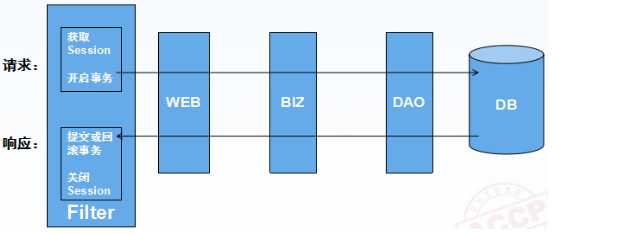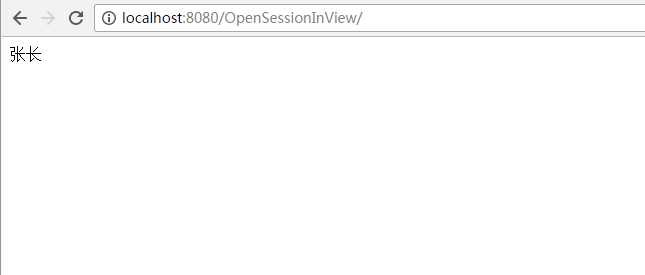标签:
Open Session In View模式的主要思想是:在用户的每一次请求过程始终保持一个Session对象打开着

实现步骤:
步骤一.创建一个Web项目,创建包cn.happy.util,创建HibernateUtil工具类
public class HibernateUtil{
private static final ThreadLocal sessionTL=new ThreadLocal();
private static Configuration cfg;
private final static SessionFactory factory;
static{
cfg=new Configuration().configure();
factory=cfg.buildSessionFactory();
}
public static Session currentSession()
{
Session session=(Session)sessionTL.get();
if(session==null)
{
session=factory.openSession();
sessionTL.set(session);
}
return session;
}
public static void closeSession()
{
Session session=(Session) sessionTL.get();
sessionTL.set(null);
session.close();
}
}
步骤二.创建包cn.happy.entity,创建实体类Emp和Emp.hbm.xml小配置文件
public class Emp {
private Integer empId;
private String empName;
public Integer getEmpId() {
return empId;
}
public void setEmpId(Integer empId) {
this.empId = empId;
}
public String getEmpName() {
return empName;
}
public void setEmpName(String empName) {
this.empName = empName;
}
<?xml version="1.0"?>
<!DOCTYPE hibernate-mapping PUBLIC
"-//Hibernate/Hibernate Mapping DTD 3.0//EN"
"http://www.hibernate.org/dtd/hibernate-mapping-3.0.dtd">
<hibernate-mapping package="cn.happy.entity">
<class name="Emp" table="Emps">
<id name="empId">
<generator class="native">
</generator>
</id>
<property name="empName"></property>
<!-- 植入一个Dept对象 多对一 -->
</class>
</hibernate-mapping>
步骤三.创建包cn.happy.Dao创建类MyDao
public class MyDao{
public Object get(Class classz,Serializable id)
{
Object obj=HibernateUtil.currentSession().load(classz,id);
return obj;
}
}
步骤四.创建包cn.happy.biz创建类MyBiz
public class MyBiz
{
public Object get(Class classz,Serializable id)
{
MyDao dao=new MyDao();
Obejct obj=dao.get(classz,id);
return obj;
}
}
步骤五.创建cn.happy.filter包创建类MyFilter,实现Filter接口,重写doFilter方法
public void doFilter(ServletRequet request,ServletResponse response,FilterChain arg2) throw IOException,ServletExption{
Session session=null;
Transaction tx=null;
session=HibernateUtil.currentSession();
tx=session.beginTransaction();
arg2.doFilter(request,response);
tx.commit();
HibernateUtil.closeSession();
}
步骤六.创建大配置文件hibernate.cfg.xml
<?xml version=‘1.0‘ encoding=‘utf-8‘?>
<!DOCTYPE hibernate-configuration PUBLIC
"-//Hibernate/Hibernate Configuration DTD 3.0//EN"
"http://www.hibernate.org/dtd/hibernate-configuration-3.0.dtd">
<hibernate-configuration>
<session-factory>
<!-- Database connection settings 数据库连接设置 -->
<!-- 驱动类 -->
<property name="connection.driver_class">oracle.jdbc.OracleDriver</property>
<!-- url地址 -->
<property name="connection.url">jdbc:oracle:thin:@localhost:1521:orcl</property>
<property name="connection.username">Hibernate</property>
<property name="connection.password">orcl</property>
<!-- SQL dialect (SQL 方言) -->
<property name="dialect">org.hibernate.dialect.Oracle10gDialect</property>
<!--在控制台打印后台的SQL语句 -->
<property name="show_sql">true</property>
<!-- 格式化显示SQL -->
<!-- <property name="format_sql">true</property> -->
<!-- 自动生成表 -->
<property name="hbm2ddl.auto">update</property>
<!-- 关联小配置 -->
<mapping resource="cn/happy/entity/Emp.hbm.xml" />
</session-factory>
</hibernate-configuration>
步骤七.在web.xml文件中配置fileter
<?xml version="1.0" encoding="UTF-8"?>
<web-app version="2.5"
xmlns="http://java.sun.com/xml/ns/javaee"
xmlns:xsi="http://www.w3.org/2001/XMLSchema-instance"
xsi:schemaLocation="http://java.sun.com/xml/ns/javaee
http://java.sun.com/xml/ns/javaee/web-app_2_5.xsd">
<display-name></display-name>
<welcome-file-list>
<welcome-file>index.jsp</welcome-file>
</welcome-file-list>
<filter>
<filter-name>openSessionInview</filter-name>
<filter-class>cn.happy.Filter.MyFilter</filter-class>
</filter>
<filter-mapping>
<filter-name>openSessionInview</filter-name>
<url-pattern>/*</url-pattern>
</filter-mapping>
</web-app>
然后我们在index.xml文件中来显示数据
<%@ page language="java" import="java.util.*" pageEncoding="utf-8"%>
<%@page import="org.hibernate.Session"%>
<%@page import="cn.happy.Util.HibernateUtil" %>
<%@page import="org.hibernate.Transaction" %>
<%@page import="cn.happy.Biz.MyBiz" %>
<%@page import="cn.happy.entity.Emp" %>
<%
String path = request.getContextPath();
String basePath = request.getScheme()+"://"+request.getServerName()+":"+request.getServerPort()+path+"/";
%>
<!DOCTYPE HTML PUBLIC "-//W3C//DTD HTML 4.01 Transitional//EN">
<html>
<head>
<base href="<%=basePath%>">
<title>OpenSessionInview</title>
</head>
<body>
<%
MyBiz biz=new MyBiz();
<!--拿到id为1的员工,在页面显示名字-->
Object object = biz.get(Emp.class, 1);
Emp emp=(Emp)object;
%>
<%=emp.getEmpName() %>
</body>
</html>
这样我们就实现了OpenSessionInview

标签:
原文地址:http://www.cnblogs.com/szj-ang/p/5839864.html